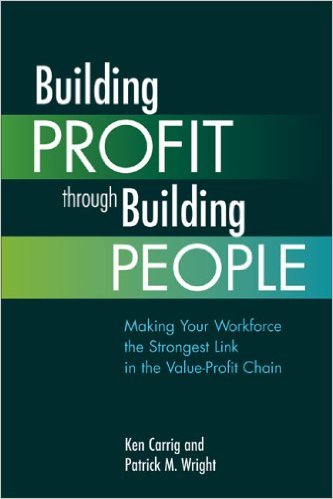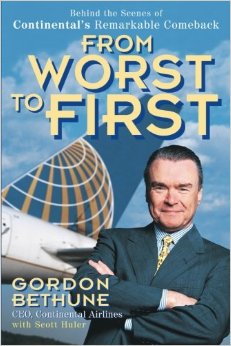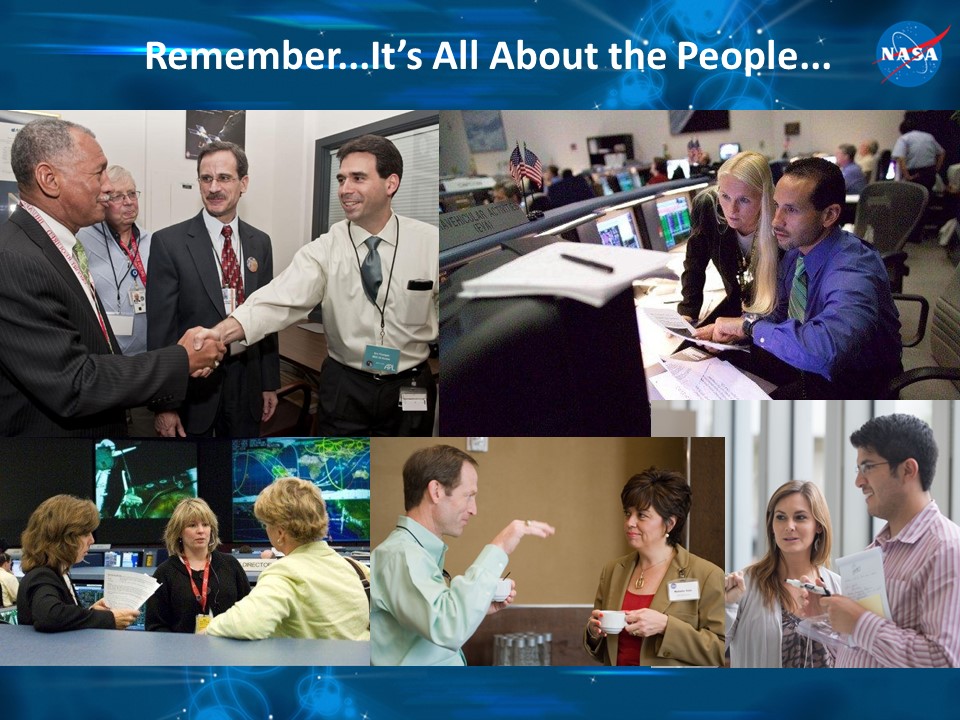Click here to return to Blog Post Intro
Building Profits through Building People by Ken Carrig & Pat Wright (2006)

Just 10 years after delivering my master’s oral thesis presentation on “Achieving Strategic Partnership as a Human Resources Representative: How I can use my MS/HRM Degree at NASA’s Johnson Space Center,” I ran across Pat Wright’s book. Always trying to stay up with the latest trends in HR from academia and industry, I picked it up.
Here’s what I learned:
A Compelling Argument: It’s All about People
Gordon Bethune’s From Worst to First: Behind the Scenes of Continental’s Remarkable Comeback stresses the importance of making employees happy so they can make customers happy, so they can ultimately make shareholders happy. Bethune focused Continental Airlines on driving revenues through customer service instead of cutting costs. Bethune says, “You know, you can make a pizza so cheap that no one will buy it.” He also offered an employee value proposition and said, “I’ve never seen a successful organization where people didn’t want to come to work every day.”

The Value Profit chain philosophy is based on customers, employees, excellence in execution, and innovation.
The Value-Profit Chain Redefined
James Heskett’s 1994 seminal article, “Putting the Service Profit Chain to Work” stated that service-industry companies could enhance profitability by improving their employee satisfaction.
In fact, a number of research studies over the years have consistently demonstrated support for the link between employee satisfaction and customer satisfaction. Satisfied associates allow companies to: (1) develop excellence in execution of routine tasks and (2) develop innovative approaches to capture business opportunities.
A highly skilled and committed workforce is difficult to imitate and becomes a source of competitive advantage.
In a 1995 study, Mark Huselid found that corporations which implemented high-performance work systems—a set of management practices aimed at building a skilled and motivated workforce—saw significantly higher profits and market values than firms that did not. In fact, a one standard deviation increase in these management practices was associated with a 20% increase in profitability!
Your Customer: A Critical Link in the Value-Profit Model
Broad industry studies show that 10% of a firm’s customers generate anywhere from 30-50% of the firm’s profits. For SYSCO Corporation—the largest marketer and distributor of food services products in North America—the top 10% generate 40-50% of profits!
As a result, businesses need to determine what their most profitable customers need and want.
Employee Loyalty and Satisfaction, and the Employer Brand
As Peter Drucker noted, people don’t work for an organization; they work for a cause.
Managers have little control over their employees’ energy level, but they can have tremendous influence over energy direction—activities in which employees engage. Customers want to work with employees who not only understand their own jobs but also how to apply that knowledge to make their customers’ business more successful. This expertise only comes with time, continued development of employees, and true engagement in the business.
Efforts to enhance employee satisfaction should start with recruiting. A company should aim to attract employees with the right fit, who really want to be with the company, find the work exciting, and come in with the confident attitude that they will enjoy their work. Consider SAS Institute and Microsoft. While both are consistently in Fortune 100’s “Best Companies to Work For”, each is very different:
SAS Institute values freedom, teamwork, leisure, and family time. They discourage employees from working more than 35 hours per week.
Microsoft, on the other hand, is marked by wealth, innovation, long hours, and no personal life based on an aggressive growth culture built around doing whatever it takes to succeed with the possibility of retiring very early and very rich.
Both approaches attract the kinds of applicants who fit their respective cultures, and again both are considered a “Best Company to Work For.”
The 5-STAR Model Employer Brand
1-STAR Companies are not engaging people at any level other than a pure transactional exchange. Employees see their organization as a “job.”
2-STAR Companies create an environment where employees engage emotionally, so they see some value in their job and take pride in doing the job.
3-STAR Companies generate loyalty. Employees see themselves as part of the company rather than free agents.
4-STAR Companies have built a culture that engages people in their jobs and in the company—at all levels from departmental, to divisional, and even to corporate.
5-STAR Companies have built a truly effective employer brand. Employees are deeply engaged in their jobs, their organization, and the larger corporation. The employer brand is synonymous with business and individual success.
To get your organization to 5-STAR:
- Ensure leaders offer direction and support. It’s important that leaders have constant and consistent communication with the rank and file about the direction of the business as well as hearing concerns from employees.
- Strengthen front-line supervisors. They make or break the day-to-day execution of your company’s critical goals!
- Reward performance
- Include employees by engaging them and leveraging the diversity of your organization
- Address employees’ quality of life
The 5-STAR Management Model
On-going self-assessments are crucial in helping establish and institutionalize cultures that focus on the connection between associates and customers and the win-win relationship between them.
Not all components of the model are equal. Front-line supervisors, leadership support, and rewards have the greatest impact on associate satisfaction. Research shows that being trustworthy, showing empathy, and creating meaning are characteristics that differentiate high-performing leaders from the rest.
Testing the 5-STAR Model
At SYSCO, across the board, you can see significant differences in performance between companies that scored in the top 25% in terms of work climate compared with those that scored in the bottom 25%. The top 25% shared a number of common best practices and areas of high performance. In the top 25%, satisfied employees work harder and smarter to deliver efficient and effective service to customers. These employees keep operational costs down while maximizing sales from customers.

Embedding the 5-STAR Model
By allowing leaders freedom to choose whether to adopt the 5-STAR model, using data to elicit action, providing tools to help them implement the model, and demonstrating how the tools improve performance, SYSCO has persuaded its companies to almost universally embed the 5-STAR approach more rapidly than ever would have happened via corporate mandate.
Building Dynamic 5-STAR Capability
A few years ago, senior line executives at a Fortune 100 company described alignment of management practices at the company as “extremely well aligned with each other…the problem is that they are all aligned around a strategy that no longer exists.”
A Strategic Summon for Human Resources
In their book, The HR Value Proposition, Dave Ulrich and Wayne Brockbank note that personal credibility is a ticket to entry in the HR field. What is new is the mastery of the business and skill in managing change.
Implicit in strategic HR and in what the HR function delivers is a concept that is of increasing importance: an analytical approach to HR. In contrast to the HR professionals’ previous passive, order-taking role, an analytical approach requires (a) proactively conceptualizing problems and devising systems-oriented solutions, and (b) having the ability to gather, analyze, interpret, and apply data of all kinds. Being proactive means that HR professionals move from waiting for directions or information from other business leaders to gathering, analyzing, and disseminating the data that are needed.
HR professionals cannot be effective unless they are passionate about making the lives of employees more productive & purposeful and unless they are committed to becoming strategic business partners. HR team members can have significant strategic impact when they:
- are smart about the business;
- know what is expected of them;
- determine how to influence most effectively;
- identify what is right and practical; and
- stand for what is right, not necessarily popular.
While this book is now 8 years old, the lessons remain helpful for HR organizations and HR professionals alike. Organizations must remember—as I regularly tell our leaders at NASA—that it really is all about the people!

